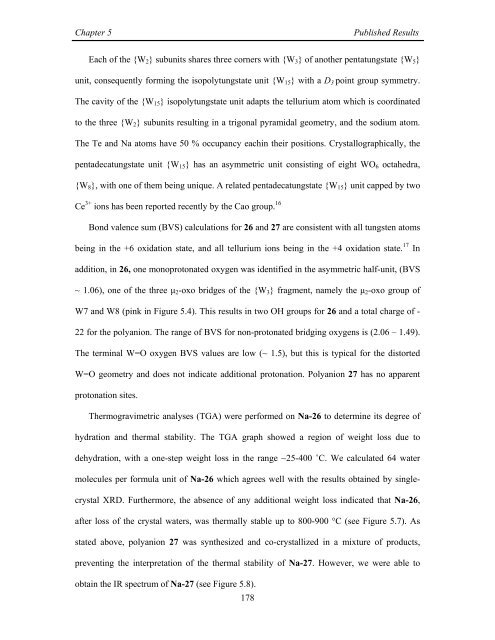Synthesis and Structural Characterization of ... - Jacobs University
Synthesis and Structural Characterization of ... - Jacobs University
Synthesis and Structural Characterization of ... - Jacobs University
Create successful ePaper yourself
Turn your PDF publications into a flip-book with our unique Google optimized e-Paper software.
Chapter 5<br />
Published Results<br />
Each <strong>of</strong> the {W 2 } subunits shares three corners with {W 3 } <strong>of</strong> another pentatungstate {W 5 }<br />
unit, consequently forming the isopolytungstate unit {W 15 } with a D 3 point group symmetry.<br />
The cavity <strong>of</strong> the {W 15 } isopolytungstate unit adapts the tellurium atom which is coordinated<br />
to the three {W 2 } subunits resulting in a trigonal pyramidal geometry, <strong>and</strong> the sodium atom.<br />
The Te <strong>and</strong> Na atoms have 50 % occupancy eachin their positions. Crystallographically, the<br />
pentadecatungstate unit {W 15 } has an asymmetric unit consisting <strong>of</strong> eight WO 6 octahedra,<br />
{W 8 }, with one <strong>of</strong> them being unique. A related pentadecatungstate {W 15 } unit capped by two<br />
Ce 3+ ions has been reported recently by the Cao group. 16<br />
Bond valence sum (BVS) calculations for 26 <strong>and</strong> 27 are consistent with all tungsten atoms<br />
being in the +6 oxidation state, <strong>and</strong> all tellurium ions being in the +4 oxidation state. 17 In<br />
addition, in 26, one monoprotonated oxygen was identified in the asymmetric half-unit, (BVS<br />
~ 1.06), one <strong>of</strong> the three μ 2 -oxo bridges <strong>of</strong> the {W 3 } fragment, namely the μ 2 -oxo group <strong>of</strong><br />
W7 <strong>and</strong> W8 (pink in Figure 5.4). This results in two OH groups for 26 <strong>and</strong> a total charge <strong>of</strong> -<br />
22 for the polyanion. The range <strong>of</strong> BVS for non-protonated bridging oxygens is (2.06 – 1.49).<br />
The terminal W=O oxygen BVS values are low (~ 1.5), but this is typical for the distorted<br />
W=O geometry <strong>and</strong> does not indicate additional protonation. Polyanion 27 has no apparent<br />
protonation sites.<br />
Thermogravimetric analyses (TGA) were performed on Na-26 to determine its degree <strong>of</strong><br />
hydration <strong>and</strong> thermal stability. The TGA graph showed a region <strong>of</strong> weight loss due to<br />
dehydration, with a one-step weight loss in the range ~25-400 ˚C. We calculated 64 water<br />
molecules per formula unit <strong>of</strong> Na-26 which agrees well with the results obtained by singlecrystal<br />
XRD. Furthermore, the absence <strong>of</strong> any additional weight loss indicated that Na-26,<br />
after loss <strong>of</strong> the crystal waters, was thermally stable up to 800-900 °C (see Figure 5.7). As<br />
stated above, polyanion 27 was synthesized <strong>and</strong> co-crystallized in a mixture <strong>of</strong> products,<br />
preventing the interpretation <strong>of</strong> the thermal stability <strong>of</strong> Na-27. However, we were able to<br />
obtain the IR spectrum <strong>of</strong> Na-27 (see Figure 5.8).<br />
178

















